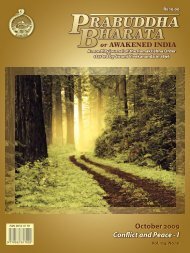October 2011 - Advaita Ashrama
October 2011 - Advaita Ashrama
October 2011 - Advaita Ashrama
You also want an ePaper? Increase the reach of your titles
YUMPU automatically turns print PDFs into web optimized ePapers that Google loves.
14<br />
these divisions are merely from the human standpoint.<br />
Consciousness belongs to God and it is<br />
singular, there are not many types of consciousness,<br />
nor are there divisions in it. As Sri Ramakrishna<br />
would say, a stick floating on water does<br />
not divide the water. Nature has many forms,<br />
but consciousness is everywhere. In the powerful<br />
words of the Aitareya Upanishad: ‘All these<br />
are impelled by Consciousness; all these have<br />
Consciousness as the giver of their reality; the<br />
universe has Consciousness as its eye and Consciousness<br />
as its end. Consciousness is Brahman.’<br />
The Taittiriya Upanishad speaks of the one<br />
and the many thus: ‘He [God] wished, “Let me<br />
be many, let me be born.” He undertook a deliberation.<br />
Having deliberated, he created all this<br />
that exists. That (Brahman), having created (that),<br />
entered into that very thing. And having entered<br />
there, It became the formed and the formless, the<br />
defined and the undefined, the sustaining and<br />
the non-sustaining, the sentient and the insentient,<br />
the true and the untrue. Truth became all<br />
this that there is. They call that (Brahman) Truth.’<br />
How God creates is declared by Sri Ramakrishna<br />
through one of his experiences: ‘One day He<br />
[God] showed me the maya of Mahamaya. A<br />
small light inside a room began to grow, and at last<br />
it en veloped the whole universe.’ This experience<br />
coincides with what the Katha Upanishad says:<br />
‘He who—being one, the controller, and the inner<br />
Self of all—makes a single form multifarious.’<br />
Though we run after and experience the<br />
many, in our perceptions and also deep down<br />
we have that faint knowledge of the one running<br />
through the many, for that is our nature.<br />
Yet, often times we forget this nature of ours,<br />
and for some fortunate ones it comes back in full<br />
force. Once near Vrindavan a hungry and tired<br />
Swami Turiyananda kept brooding over the fact<br />
that everyone was engaged in some form of work<br />
and was producing something, while he lived<br />
618<br />
Prabuddha Bharata<br />
like a vagabond. Distressed, he fell asleep under<br />
a tree. ‘There he had a vision: He saw himself<br />
outside of his body, and he was looking at himself<br />
while he slept. He saw his body expanding<br />
and expanding, until there was no end to it. The<br />
body became so large that it covered the entire<br />
world. Then he addressed himself: “Oh, you are<br />
not a vagabond. You are one with the universe.<br />
You are the all-pervading Atman.” So thinking,<br />
he jumped up and felt very happy. His despondency<br />
was at an end.’<br />
There is another deeper dimension to the<br />
identity of we in the one and the many and this<br />
is made clear in another similar experience of<br />
Swami Shivananda at Ootacamund: ‘The other<br />
day as I sat here silently watching the [Nilgiris]<br />
blue mountain ranges I experienced something.<br />
I saw a luminous figure coming out of this body,<br />
and it grew and grew, till at last it enveloped the<br />
whole world. [Heaving a deep sigh he then remarked]:<br />
The Master is my Paramatman, the<br />
supreme Self. It is He who pervades the whole<br />
universe. “A quarter of His is this whole universe;<br />
His other three immortal quarters are in<br />
the bright region” (Purusha Sukta).’<br />
Sri Ramakrishna, as the Atman or Paramatman,<br />
is thus the real one and the many. And this<br />
was very forcefully brought out at Kashipur during<br />
his terminal illness. Sri Ramakrishna could<br />
not speak because of pain. One day he placed his<br />
hand on his heart and whispered to Narendra,<br />
the future Swami Vivekananda: ‘“I see that all<br />
things—everything that exists—have come from<br />
this.” He asks Narendra by a sign, “What did you<br />
understand?” Narendra: “All created objects have<br />
come from you.” The Master’s face beams with<br />
joy. He says to Rakhal, “Did you hear what he<br />
said?”’ Did we hear properly what Swamiji said? It<br />
is Sri Ramakrishna who is the one and the many.<br />
He says that God, ‘appears manifold through<br />
maya; but in reality He alone exists.’ P<br />
PB <strong>October</strong> <strong>2011</strong>

















